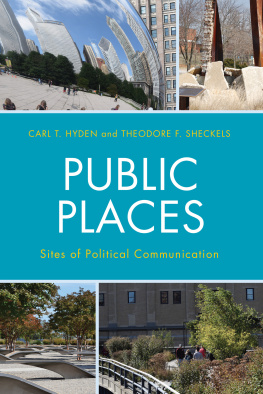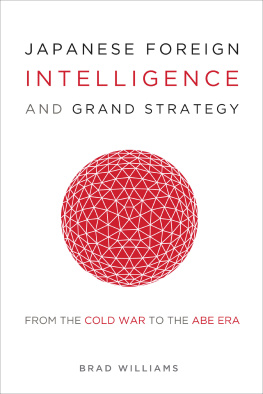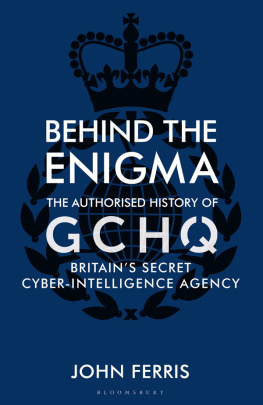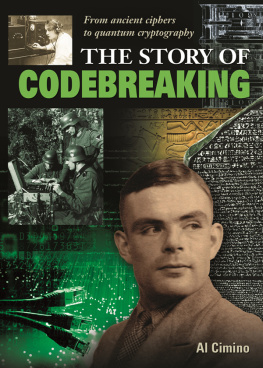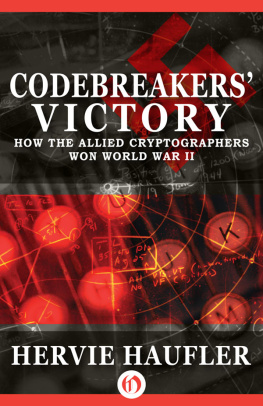A LSO BY S TEPHEN B UDIANSKY
Biography Mad Music: Charles Ives, the Nostalgic Rebel
Her Majestys Spymaster
History Blacketts War
Perilous Fight
The Bloody Shirt
Air Power
Battle of Wits
Natural History The Character of Cats
The Truth About Dogs
The Nature of Horses
If a Lion Could Talk
Natures Keepers
The Covenant of the Wild
Fiction Murder, by the Book
For Children The World According to Horses
THIS IS A BORZOI BOOK PUBLISHED BY ALFRED A. KNOPF
Copyright 2016 by Stephen Budiansky All rights reserved. Published in the United States by Alfred A. Knopf, a division of Penguin Random House LLC, New York, and distributed in Canada by Random House of Canada, a division of Penguin Random House Canada Limited, Toronto.
www.aaknopf.com
Knopf, Borzoi Books, and the colophon are registered trademarks of Penguin Random House LLC.
Library of Congress Cataloging-in-Publication Data Names: Budiansky, Stephen, author.
Title: Code warriors : NSAs codebreakers and the secret intelligence war against the Soviet Union / by Stephen Budiansky.
Description: New York : Alfred A. Knopf, 2016. | Includes bibliographical references and index.
Identifiers: LCCN 2015045330
| ISBN 978-0-385-35266-6 (hardcover) | ISBN 978-0-385-35267-3 (ebook) Subjects: LCSH: United States. National Security AgencyHistory. |
CryptographyUnited StatesHistory | United StatesForeign relationsSoviet Union. | Soviet UnionForeign relationsUnited States.
Classification: LCC UB256.U6 B83 2016 | DDC 327.7304709/045dc23 LC record available at http://lccn.loc.gov/2015045330.
eBook ISBN9780385352673
Cover image: Russian M-125 Fialka Cipher Machine (detail). Courtesy of Glenn Henry, Glenns Computer Museum.
Cover design by Chip Kidd
Maps by Dave Merrill
TO DAVID KAHN,
who led the way
C ONTENTS
Arlington Hall, 1943Assembly-line cryptologyGetting everythingThe Soviet one-time-pad systemsFuture of the special relationshipSpying in peacetimeLike a deserted barn
A defector in OttawaReading depthsRussian teleprintersTICOM and the Karrenberg PartyCaviar and LongfellowLow pay and too many military bossesCable intercept and moral murkiness
NKGB messages and Soviet spycraftA Russian genius for conspiracyPlausible deniabilityThe perils of prosecution Soviet rotor machinesWho interprets signals intelligence?
Computers for cryptanalysisERAs Task 13Special-purpose comparatorsAbner, Goldberg, Demon, and SwishBlack Friday, October 1948Russian plaintext on the Plantation
Ferret flightsShootdown in the BalticTraffic analysis and ELINTLooking the other way in KoreaMacArthurs SIGINT blindnessLow-level intercept and the air warThe birth of NSAPhilby, Maclean, and Weisband
Reasonable dictator Ralph J. CanineSquare spies, obtuse securityInquisition by polygraphA Dutch moleIntercept overloadThe move to Fort Meade
Improving on EnigmaTheremins ThingThe Berlin TunnelTEMPESTHungary, Suez, and the chaos of 1956Harvest, Lightning, and IBM hegemonyInformation theory, and the changing of the cryptanalytic old guard
Martin and MitchellGlimmers of accountabilityThe Boris deal and cryptographic innocents abroadSIGINT in spaceCuban Missile CrisisCritics and Bullmeese
Lyndon Johnsons SIGINT fascinationGulf of Tonkin, 1964Learning to fight, againTet and the Ultra Syndrome USS PuebloGrowing spectrum, shrinking resources
SIGINT sclerosisDisreputable if not outright illegalBattle of the bugs, continuedThe Inman era and the last hurrah of the codebreakers, 1979Pelton, Walker, and the year of the spy, 1985
A BBREVIATION
| AEC | Atomic Energy Commission |
| AFSA | Armed Forces Security Agency |
| ASA | Army Security Agency |
| ASAPAC | Army Security Agency, Pacific |
| COMINT | communications intelligence |
| CSAW | Communications Supplementary Activities, Washington (U.S. Navy) |
| DF | direction finding |
| ELINT | electronic intelligence |
| FISC | Foreign Intelligence Surveillance Court |
| GC&CS | Government Code and Cypher School (UK) |
| GCHQ | Government Communications Headquarters (UK) |
| GRU | Main Intelligence Directorate (Soviet military intelligence) |
| HF | high frequency |
| HUAC | House Un-American Activities Committee |
| KGB | Soviet Committee of State Security (195491) |
| MGB | Soviet Ministry of State Security (194654; predecessor to KGB) |
| MI5 | UK counterintelligence |
| MVD | Soviet Ministry of Internal Affairs (194691) |
| NKGB | Peoples Commissariat for State Security (Soviet foreign security service, 194346; predecessor to MGB and KGB) |
| NKVD | Peoples Commissariat for Internal Affairs (Soviet internal security service, predecessor to MVD; incorporated State Security, 193443) |
| NSC | National Security Council |
| NSG | Naval Security Group |
| ONI | Office of Naval Intelligence |
| Op-20-G | Office of Naval Communications cryptanalytic section |
| OSS | Office of Strategic Services |
| PFIAB | Presidents Foreign Intelligence Advisory Board |
| RAM | rapid analytical machinery |
| SAC | Strategic Air Command |
| SCAMP | Special Cryptologic Advisory Math Panel |
| SIGINT | signals intelligence |
| SIS | Secret Intelligence Service (UK) |
| TICOM | Target Intelligence Committee (Allied project to capture German cryptologists and cryptologic material at end of World War II) |
| USAFSS | U.S. Air Force Security Service |
| USCIB | U.S. Communications Intelligence Board |
| USIB | U.S. Intelligence Board |
A UTHOR S N OTE
In May 2013, a twenty-nine-year-old computer security expert who had worked for three months as a $200,000-a-year contractor for the National Security Agency in Hawaii told his employer he needed to take a leave of absence for a couple of weeks to receive treatment for the epileptic condition he had recently been diagnosed with. On May 20, Edward J. Snowden boarded a flight to Hong Kong, carrying with him computer drives to which he had surreptitiously copied thousands of classified intelligence documents. Their contents, revealing copious details about NSAs domestic surveillance of telephone and e-mail communications, would begin appearing two weeks later in a series of sensational articles in the Guardian and the Washington Post.
It was a move he had been secretly preparing for some time, having secured the job with the specific aim of gaining access to classified NSA material. (He was ultimately able to do so only by duping more than twenty coworkers into giving him their computer passwords, which he said he needed for his duties as a systems administrator; most of the colleagues whom he betrayed were subsequently fired.) Snowden would later explain that he chose Hong Kong as his place of intended sanctuary because they have a spirited commitment to free speech and the right of political dissentan assertion that would have come as a surprise to members of the citys pro-democracy movement, whose peaceful mass protests the following year would be efficiently crushed by the Hong Kong authorities at the behest of their Chinese Communist Party masters in Beijing.


